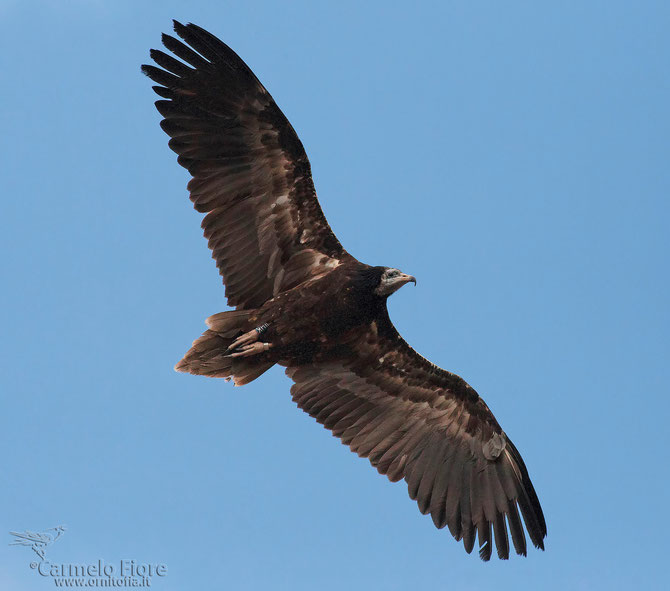
Captive-bred Egyptian Vulture Kate was found dead in Western Sicily in early January, after spending only two months on the island.
Kate was one of the Egyptian Vultures that were released this summer in Italy. Our Italian colleagues released a total of eight captive-bred Egyptian Vultures in Basilicata between July and August. CERM Centro Rapaci Minacciati Association and ISPRA Istituto Superiore per la Protezione e la Ricerca Ambientale carried out these releases as part of theLIFE Egyptian Vulture project to support the Italian population of this species, which dramatically dropped over the past century. The vultures were equipped with satellite transmitters to monitor their movements and tackle threats. The Vulture Conservation Foundation (VCF) provided four of these transmitters, including the one of Kate.
Kate’s movements in the wild

After leaving the release area on 30 September, Kate headed south and reached the west coast of Sicily on 18 October. Since then, she was exploring the area in search of food. She was closely followed and monitored by volunteers who protected her and, when possible, provided her with some food and support. This monitoring was possible thanks to the satellite transmitter and the excellent coordination by Guido Ceccolini, director of CERM, who communicated the real-time position of Kate to volunteers. Unfortunately, at the end of December, the GPS data indicated that Kate, near Licata, was no longer moving.
Finding Kate’s body

On 3 January, the ornithologists Agostino Cantavenera, Giuseppe Cantavenera and Andrea Ciaccio set out in search of Kate. The three volunteers managed to find the carcass of the poor animal, completely eaten by some birds of prey. What little remained of Kate’s body was handed over to the CITES Carabinieri-Forestali of Palermo, who arrived on the spot and took the remains to the Istituto Zooprofilattico Sperimentale of Palermo, where they tried to determine the cause of the death of the vulture.
Possible causes of death
An initial radiological examination has ruled out the presence of pellets in the bones, but this does not exclude the possibility that Kate was shot to death. Another cause of death could be the ingestion of poisoned baits, but we need to wait for the results of toxicological tests to see. It can be excluded, however, that death was caused by electrocution or impact against wind turbines because there is no such infrastructure in the area.
Western Sicily a death trap for birds of prey
For now, the serious fact remains that after spending only two months in Sicily, Kate died. It is the fourth Egyptian Vulture among those released by CERM over the years and equipped with transmitters that died or ‘disappeared’ in Western Sicily.
In 2018, Clara, another young vulture who was freed in Basilicata, met a horrible fate and was shot dead in Trapani during her migration. This episode led to a collection of over 111,000 signatures to urge the authorities to step up the fight against poaching and create feeding stations within protected areas. In May 2019, the CERM Association handed these signatures over to the Ministry of the Environment but are still awaiting a response.
Western Sicily represents a giant ‘black hole’ for birds of prey that become victims from the widespread poaching. It is necessary to tackle this illegality for the sake of raptors and the Egyptian Vulture, the most endangered bird of prey species in Italy.
Wintering movements from the other Egyptian Vultures released in Italy

The VCF provided satellite transmitters to many Egyptian Vultures released in Italy by CERM over the years, and has been closely following their movements. Most of these birds are currently wintering in Africa. Here are what these vultures have been up in the past few months.
Jane and Diego were released in the summer of 2019 in Italy, just like Kate.
Jane crossed on 4 October over Malta and made it safely to Africa. She is overwintering in Niger and Nigeria.
Diego flew to Sicily 20 days later than Jane, and so far did not travel to Africa, but is exploring different areas in Sicily.
Sara and Tobia were released in Italy in 2015. Both birds migrated to Africa after their release and have not been back to Italy until 2019. Both birds started their migration back to Africa at the end of August 2019.
Sara is spending her 5th winter in Niger – maybe she will return in spring and breed.
Tobia migrated to Africa successfully together with Sara. Every year, we do not receive GPS data during the winter months, but hopefully, Tobia will return and maybe even breed this summer. He is the same age as Sara.
Sara and Tobia chose the ‘better’ (and safer) path to cross to Africa this year.
Follow the movements of GPS tagged Egyptian Vultures by visiting our online public maps.
We hope these vultures will have a long future in the wild.
Sign up to our newsletter and never miss any vulture news.



